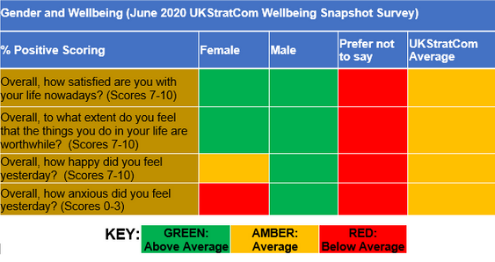Guest blog by Martin Short MCIPD, Defence Intelligence Head of Wellbeing, Diversity and Inclusion
In early 2018 Defence Intelligence (DI), a large MoD business unit of around 5000 staff, began a new evidence-based Workplace Wellbeing programme. The core recommendations of the Farmer/Stevenson Review (‘Thriving at Work’) were used to guide this activity and DI has been experimenting with tools to address the Review’s recommendation that all UK employers ‘Routinely monitor employee mental health and wellbeing’.
While it is helpful to understand ‘how employees are doing’ by measuring Wellbeing as an outcome using metrics such as the ONS 4 Subjective Wellbeing Questions, it is even better if organisations can go beyond this and identify and quantify the influence of those workplace factors that actually drive Wellbeing outcomes. These factors can include issues such as relationships, working environment, job quality and security, perceptions of fairness, and the sense that employees feel valued and recognised for their contributions. Taking such measurements not only enhances understanding of organisational culture but also provides opportunities to address challenges identified in a more targeted and resource efficient manner.
One of our early actions in the DI Wellbeing Programme was to bring our Wellbeing and Diversity and Inclusion (D&I) functions together in the same team - and this has already delivered benefits. We have found that Wellbeing education can be a powerful enabler for D&I activity. For instance when any employee (regardless of demographic background) is encouraged to reflect on the personal Wellbeing impact of what it feels like to be marginalised within a team, then this can help create a real empathy with those who may feel excluded simply because of their gender, colour or sexual orientation. The impact of any form of exclusion is bad for individual Wellbeing, bad for team effectiveness and bad for organisational capability.
In mid-2020 we used the What Works Centre for Wellbeing Employee Wellbeing Snapshot Survey to explore this Wellbeing/D&I dimension across staff in DI’s parent organisation - UK Strategic Command (UKStratCom). We looked at how Wellbeing varied across workforce demographic characteristics which included:
- Ethnic Background
- Gender
- Sexual Orientation/Identity
- People with Disabilities/Health Conditions
- Age
There were some interesting findings. Some of these resonated with what we already knew from wider academic research. For instance, there were gender differences - women scored higher than men in feeling that what they did in life was worthwhile, but they were slightly more anxious than men. Staff from BAME backgrounds reported slightly higher levels of subjective Wellbeing than White responders but, as with women, anxiety levels were slightly higher. We also found that most staff tended to get happier and less anxious with age.
There was however one pattern in the data we had not expected. Around 10% of responders did not declare their demographic details and we ended up calling this group the ‘Prefer not to Says’. When we considered this ‘Prefer Not to Say’ group as a demographic entity in its own right we were able to see that those who did not declare their demographic details appeared to have the lowest Wellbeing levels of any other group. The comparison chart for gender and Wellbeing is illustrated (below) as an example, but interestingly the red ‘below average’ outcomes for the ‘Prefer not to Say’ grouping is a constant - whichever demographic variable one compares it to.

So, what is behind this apparent association between lower Wellbeing levels and a reluctance to declare personal demographic characteristics? The simple answer is that we don’t know - and we are unlikely to be in a position to understand the issue, let alone fix it, unless a significant proportion of those who currently ‘Prefer Not to Say’ change their minds. However, we do now understand much more than we did about Wellbeing variations by demographics and we also know we need to explore what is going on among the ‘Prefer not to Says’.
Convincing employees to invest their time participating in surveys can undoubtedly be challenging. Staff in large organisations often experience survey fatigue, they can be cynical about whether survey findings will be acted upon and there can also be concerns about confidentiality and how the data will be used. Overcoming this means that it is essential to build trust in organisational commitment to improving Workplace Wellbeing - but taking an evidence-based approach is without doubt starting to pay dividends in Defence Intelligence as we seek to make it a place where staff can thrive and give their best to the organisation.

